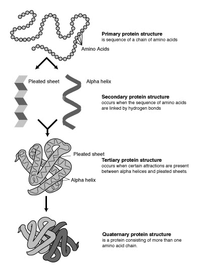
Predicting protein stability and solubility changes upon mutations: data perspective
Sign Up to like & getrecommendations! Published in 2020 at "ChemCatChem"
DOI: 10.1002/cctc.202000933
Abstract: Understanding mutational effects on protein stability and solubility is of particular importance for creating industrially relevant biocatalysts, resolving mechanisms of many human diseases, and producing efficient biopharmaceuticals, to name a few. For in silico predictions,… read more here.
Keywords: predicting protein; protein stability; stability solubility; solubility changes ... See more keywords

An insightful recollection for predicting protein subcellular locations in multi-label systems.
Sign Up to like & getrecommendations! Published in 2019 at "Genomics"
DOI: 10.1016/j.ygeno.2019.08.008
Abstract: A systematic introduction has been presented for the recent advances in predicting protein subcellular localization in the multi-label systems, where the constituent proteins may simultaneously occur or move between two or more location sites and… read more here.
Keywords: predicting protein; recollection predicting; multi label; label systems ... See more keywords

Predicting Protein-Peptide Complex Structures by Accounting for Peptide Flexibility and the Physicochemical Environment
Sign Up to like & getrecommendations! Published in 2022 at "Journal of chemical information and modeling"
DOI: 10.1021/acs.jcim.1c00836
Abstract: Predicting protein-peptide complex structures is crucial to the understanding of a vast variety of peptide-mediated cellular processes and to peptide-based drug development. Peptide flexibility and binding mode ranking are the two major challenges for protein-peptide… read more here.
Keywords: peptide; protein peptide; predicting protein; peptide complex ... See more keywords

Predicting Protein-Ligand Binding and Unbinding Kinetics with Biased MD Simulations and Coarse-Graining of Dynamics: Current State and Challenges
Sign Up to like & getrecommendations! Published in 2023 at "Journal of chemical information and modeling"
DOI: 10.1021/acs.jcim.3c00151
Abstract: The prediction of drug-target binding and unbinding kinetics that occur on time scales between milliseconds and several hours is a prime challenge for biased molecular dynamics simulation approaches. This Perspective gives a concise summary of… read more here.
Keywords: predicting protein; binding unbinding; unbinding kinetics; current state ... See more keywords

Predicting Protein-Peptide Interactions: Benchmarking Deep Learning Techniques and a Comparison with Focused Docking.
Sign Up to like & getrecommendations! Published in 2023 at "Journal of chemical information and modeling"
DOI: 10.1021/acs.jcim.3c00602
Abstract: The accurate prediction of protein structures achieved by deep learning (DL) methods is a significant milestone and has deeply impacted structural biology. Shortly after its release, AlphaFold2 has been evaluated for predicting protein-peptide interactions and… read more here.
Keywords: interactions benchmarking; predicting protein; protein peptide; peptide interactions ... See more keywords

A Machine Learning Protocol for Predicting Protein Infrared Spectra.
Sign Up to like & getrecommendations! Published in 2020 at "Journal of the American Chemical Society"
DOI: 10.1021/jacs.0c06530
Abstract: Infrared (IR) absorption provides important chemical fingerprints of biomolecules. Protein secondary structure determination from IR spectra is tedious since its theoretical interpretation requires repeated expensive quantum-mechanical calculations in a fluctuating environment. Herein we present a… read more here.
Keywords: protein; machine learning; predicting protein; protocol predicting ... See more keywords

Predicting protein–membrane interfaces of peripheral membrane proteins using ensemble machine learning
Sign Up to like & getrecommendations! Published in 2022 at "Briefings in Bioinformatics"
DOI: 10.1093/bib/bbab518
Abstract: Abstract Abnormal protein–membrane attachment is involved in deregulated cellular pathways and in disease. Therefore, the possibility to modulate protein–membrane interactions represents a new promising therapeutic strategy for peripheral membrane proteins that have been considered so… read more here.
Keywords: peripheral membrane; predicting protein; membrane proteins; machine learning ... See more keywords

NetSolP: predicting protein solubility in Escherichia coli using language models
Sign Up to like & getrecommendations! Published in 2022 at "Bioinformatics"
DOI: 10.1093/bioinformatics/btab801
Abstract: MOTIVATION Solubility and expression levels of proteins can be a limiting factor for large-scale studies and industrial production. By determining the solubility and expression directly from the protein sequence, the success rate of wet-lab experiments… read more here.
Keywords: language models; escherichia coli; netsolp predicting; predicting protein ... See more keywords

Predicting protein stability changes upon mutation using a simple orientational potential
Sign Up to like & getrecommendations! Published in 2023 at "Bioinformatics"
DOI: 10.1093/bioinformatics/btad011
Abstract: Abstract Motivation Structure-based stability prediction upon mutation is crucial for protein engineering and design, and for understanding genetic diseases or drug resistance events. For this task, we adopted a simple residue-based orientational potential that considers… read more here.
Keywords: predicting protein; upon mutation; stability; orientational potential ... See more keywords

Predicting protein‐protein interactions through sequence‐based deep learning
Sign Up to like & getrecommendations! Published in 2018 at "Bioinformatics"
DOI: 10.1093/bioinformatics/bty573
Abstract: Motivation High‐throughput experimental techniques have produced a large amount of protein‐protein interaction (PPI) data, but their coverage is still low and the PPI data is also very noisy. Computational prediction of PPIs can be used… read more here.
Keywords: protein; predicting protein; deep learning; protein protein ... See more keywords

Analyzing Effect of Multi-Modality in Predicting Protein-Protein Interactions
Sign Up to like & getrecommendations! Published in 2022 at "IEEE/ACM Transactions on Computational Biology and Bioinformatics"
DOI: 10.1109/tcbb.2022.3157531
Abstract: Nowadays, multiple sources of information about proteins are available such as protein sequences, 3D structures, Gene Ontology (GO), etc. Most of the works on protein-protein interaction (PPI) identification had utilized these information about proteins, mainly… read more here.
Keywords: protein protein; predicting protein; modal; multi ... See more keywords